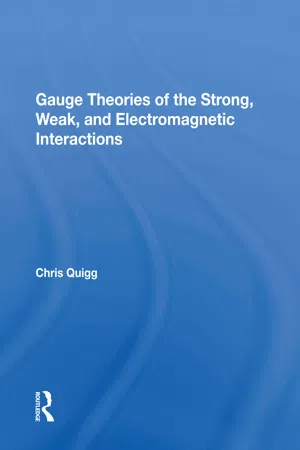CHAPTER 1
INTRODUCTION
DOI: 10.1201/9780429034978-1
High-energy physics, the science of the ultimate constituents of matter and the interactions among them, has undergone a remarkable development during the past decade. A host of new experimental results made accessible by a new generation of particle accelerators and the accompanying rapid convergence of theoretical ideas have brought to the subject a new coherence and have raised new aspirations. Many thoughtful scientists are expressing optimism that a grand synthesis of natural phenomena is at hand.1 Indeed, it will be seen in the course of this volume that a unified description of the strong, weak, and electromagnetic interactions may not be just a distant dream. A qualitatively satisfactory, if not entirely satisfying, unified theory may already exist. The most sanguine observers accept this sort of “grand unification” as a fait accompli and argue that a complete Theory of the World awaits only the incorporation of gravitation.
Ours is hardly the first time in history that physicists have believed themselves close to an enduring understanding of the laws of Nature. What, then, are the grounds for believing that (whether or not “the end” is in sight) important progress is under way? Essential elements are the significance of the quark-model description of hadrons, the nonobservation of quark or lepton substructure, the notable successes of the Weinberg–Salam model of the weak and electromagnetic interactions, and the low abundance of free quarks.
The utility of the quark model as a classification tool that provides a systematic basis for hadron spectroscopy has long been appreciated. Recognition that the quark language also permits an apt description of the dynamics of hadronic interactions has come more recently. The quark-parton model underlies a quantitative phenomenology of deeply inelastic lepton–hadron scattering and of electron–positron annihilation into hadrons. The interpretation of violent collisions of hadrons in terms of the hard scattering of pointlike constituents, although for the moment somewhat schematic, is extremely appealing as well.
An elementary particle, in the time-honored sense of the term, is structureless and indivisible. Although history cautions that the physicist’s list of elementary particles is dependent upon experimental resolution, and thus subject to revision with the passage of time, it also has rewarded the hope that interactions among the elementary particles of the moment would be simpler and more fundamental than those among composite systems. Neither quarks nor leptons exhibit any structure on a scale of about 10−16 cm, the currently attained resolution. We thus have no experimental reason but tradition to suspect that they are not the ultimate elementary particles. For nearly all of this book they will be considered as the fundamental fermions.
The appeal of unified theories of weak and electromagnetic interactions is at once esthetic and practical. The effective weak-interaction Lagrangian that evolved from Fermi’s description of nuclear β-decay, and provided a serviceable low-energy phenomenology, is now seen to be the limiting form of a renormalizable field theory. ...
